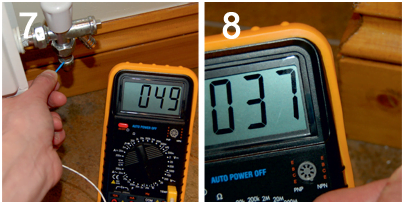If some radiators in your heating system are cold and others hot they may need balancing.
Tool List: Radiator-bleeding key Lockshield valve adjuster or adjustable spanner Screwdriver Digital thermometer or multimeter with thermometer function :
1. Make sure all the air is bled from the radiators and then turn off the central heating and allow the radiators to cool.
2. Familiarise yourself with the valves, a lockshield valve will usually have a push-on cap or one that is secured with a screw through the top to remove it.
3. Older models will have a wheelhead valve on the other side just like the AEL MA16 style valve which is used to adjust the temperature manually or to turn the radiator on/off.
4. Some radiators will have a thermostatic valve just like the AEL TA8 style of valve instead of a wheelhead valve.
5. Open up the valves on all the radiators in the house by turning them anti-clockwise. Wheelhead and thermostatic valves can be turned easily by hand, but the lockshield will need the protective cap removing and a spanner and screw driver made available to adjust the flow
6. Turn the central heating back on and note down the order the radiators heat up. Those radiators nearest the boiler will normally get hot first but if you have got a lot of radiators on the system you will need an assistant to help note the heat up sequence, once the heat up sequence of radiators in the system has been listed you must turn the heating off and wait while the radiators cool down.
7. When the radiators are cool, switch the heating back on and go to the first radiator on your list. Turn the thermostatic or wheelhead valve ( flow into the radiator) fully open and then turn the lockshield valve ( flow out of the radiator) clockwise until it is closed and then open it by a quarter of a turn. Once the radiator has warmed up, take a temperature reading at the pipework on the system flow into the valve.
8. Now take a temperature reading at the flow out pipework , open the lockshield valve gradually until there’s a 11°C difference ( or in line with the dt of your system design) between the “flow in” reading you took and the “flow out” reading you took in step 7 (allow a couple of minutes after each adjustment for the temperature to change).
The temperature figures shown are a typical indication and should not be taken as the optimum figure – it’s the 11°C difference in temperature at the valves that counts or design dt that has been specified by the design engineer.
Next, check the rest of the radiators in the system following the order in the list.
The further you move away from the boiler, you’ll find the lockshield valve will have to be opened more. The last radiator may need to have the lockshield valve fully open to work at full efficiency.
Your radiators are now balanced and should work perfectly, it is important to choose the correct radiator size/ output for the room than it is to rely on balancing the system at the end of the installation.
The key part of balancing a system is measuring the temperature difference across each radiator using a thermometers that strap round the pipes at either end of the radiator are available to buy or hire, but it’s not really necessary to use these as you can also use a single digital thermometer the only down side is that it means that you cannot take simultaneous readings and you’ll have to move from one end of the radiator to the other.
A digital multimeter with temperature function can also be used


